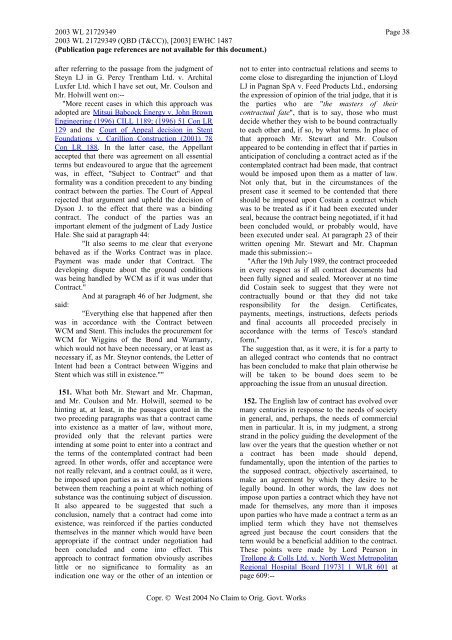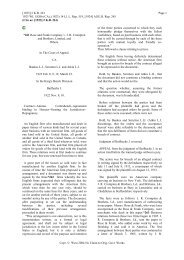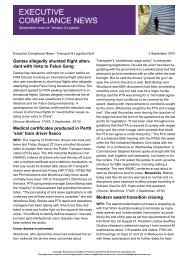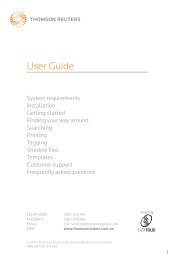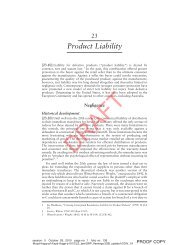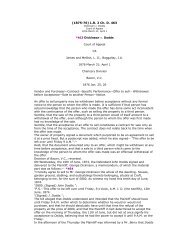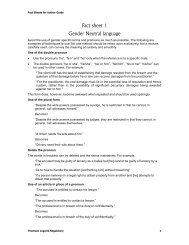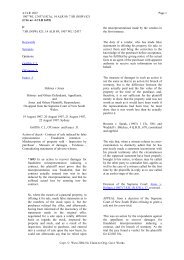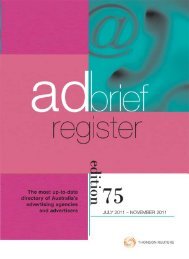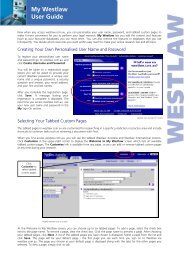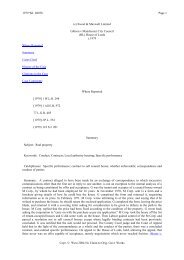Tesco v Constain - Thomson Reuters
Tesco v Constain - Thomson Reuters
Tesco v Constain - Thomson Reuters
You also want an ePaper? Increase the reach of your titles
YUMPU automatically turns print PDFs into web optimized ePapers that Google loves.
2003 WL 21729349 Page 382003 WL 21729349 (QBD (T&CC)), [2003] EWHC 1487(Publication page references are not available for this document.)after referring to the passage from the judgment ofSteyn LJ in G. Percy Trentham Ltd. v. ArchitalLuxfer Ltd. which I have set out, Mr. Coulson andMr. Holwill went on:--"More recent cases in which this approach wasadopted are HMitsui Babcock Energy v. John BrownEngineering (1996) CILL 1189; (1996) 51 Con LR129 and the HCourt of Appeal decision in StentFoundations v. Carillion Construction (2001) 78Con LR 188. In the latter case, the Appellantaccepted that there was agreement on all essentialterms but endeavoured to argue that the agreementwas, in effect, "Subject to Contract" and thatformality was a condition precedent to any bindingcontract between the parties. The Court of Appealrejected that argument and upheld the decision ofDyson J. to the effect that there was a bindingcontract. The conduct of the parties was animportant element of the judgment of Lady JusticeHale. She said at paragraph 44:"It also seems to me clear that everyonebehaved as if the Works Contract was in place.Payment was made under that Contract. Thedeveloping dispute about the ground conditionswas being handled by WCM as if it was under thatContract."And at paragraph 46 of her Judgment, shesaid:"Everything else that happened after thenwas in accordance with the Contract betweenWCM and Stent. This includes the procurement forWCM for Wiggins of the Bond and Warranty,which would not have been necessary, or at least asnecessary if, as Mr. Steynor contends, the Letter ofIntent had been a Contract between Wiggins andStent which was still in existence.""151. What both Mr. Stewart and Mr. Chapman,and Mr. Coulson and Mr. Holwill, seemed to behinting at, at least, in the passages quoted in thetwo preceding paragraphs was that a contract cameinto existence as a matter of law, without more,provided only that the relevant parties wereintending at some point to enter into a contract andthe terms of the contemplated contract had beenagreed. In other words, offer and acceptance werenot really relevant, and a contract could, as it were,be imposed upon parties as a result of negotiationsbetween them reaching a point at which nothing ofsubstance was the continuing subject of discussion.It also appeared to be suggested that such aconclusion, namely that a contract had come intoexistence, was reinforced if the parties conductedthemselves in the manner which would have beenappropriate if the contract under negotiation hadbeen concluded and come into effect. Thisapproach to contract formation obviously ascribeslittle or no significance to formality as anindication one way or the other of an intention ornot to enter into contractual relations and seems tocome close to disregarding the injunction of LloydLJ in Pagnan SpA v. Feed Products Ltd., endorsingthe expression of opinion of the trial judge, that it isthe parties who are "the masters of theircontractual fate", that is to say, those who mustdecide whether they wish to be bound contractuallyto each other and, if so, by what terms. In place ofthat approach Mr. Stewart and Mr. Coulsonappeared to be contending in effect that if parties inanticipation of concluding a contract acted as if thecontemplated contract had been made, that contractwould be imposed upon them as a matter of law.Not only that, but in the circumstances of thepresent case it seemed to be contended that thereshould be imposed upon Costain a contract whichwas to be treated as if it had been executed underseal, because the contract being negotiated, if it hadbeen concluded would, or probably would, havebeen executed under seal. At paragraph 23 of theirwritten opening Mr. Stewart and Mr. Chapmanmade this submission:--"After the 19th July 1989, the contract proceededin every respect as if all contract documents hadbeen fully signed and sealed. Moreover at no timedid Costain seek to suggest that they were notcontractually bound or that they did not takeresponsibility for the design. Certificates,payments, meetings, instructions, defects periodsand final accounts all proceeded precisely inaccordance with the terms of <strong>Tesco</strong>'s standardform."The suggestion that, as it were, it is for a party toan alleged contract who contends that no contracthas been concluded to make that plain otherwise hewill be taken to be bound does seem to beapproaching the issue from an unusual direction.152. The English law of contract has evolved overmany centuries in response to the needs of societyin general, and, perhaps, the needs of commercialmen in particular. It is, in my judgment, a strongstrand in the policy guiding the development of thelaw over the years that the question whether or nota contract has been made should depend,fundamentally, upon the intention of the parties tothe supposed contract, objectively ascertained, tomake an agreement by which they desire to belegally bound. In other words, the law does notimpose upon parties a contract which they have notmade for themselves, any more than it imposesupon parties who have made a contract a term as animplied term which they have not themselvesagreed just because the court considers that theterm would be a beneficial addition to the contract.These points were made by Lord Pearson inHTrollope & Colls Ltd. v. North West MetropolitanRegional Hospital Board [1973] 1 WLR 601 atpage 609:--Copr. © West 2004 No Claim to Orig. Govt. Works


